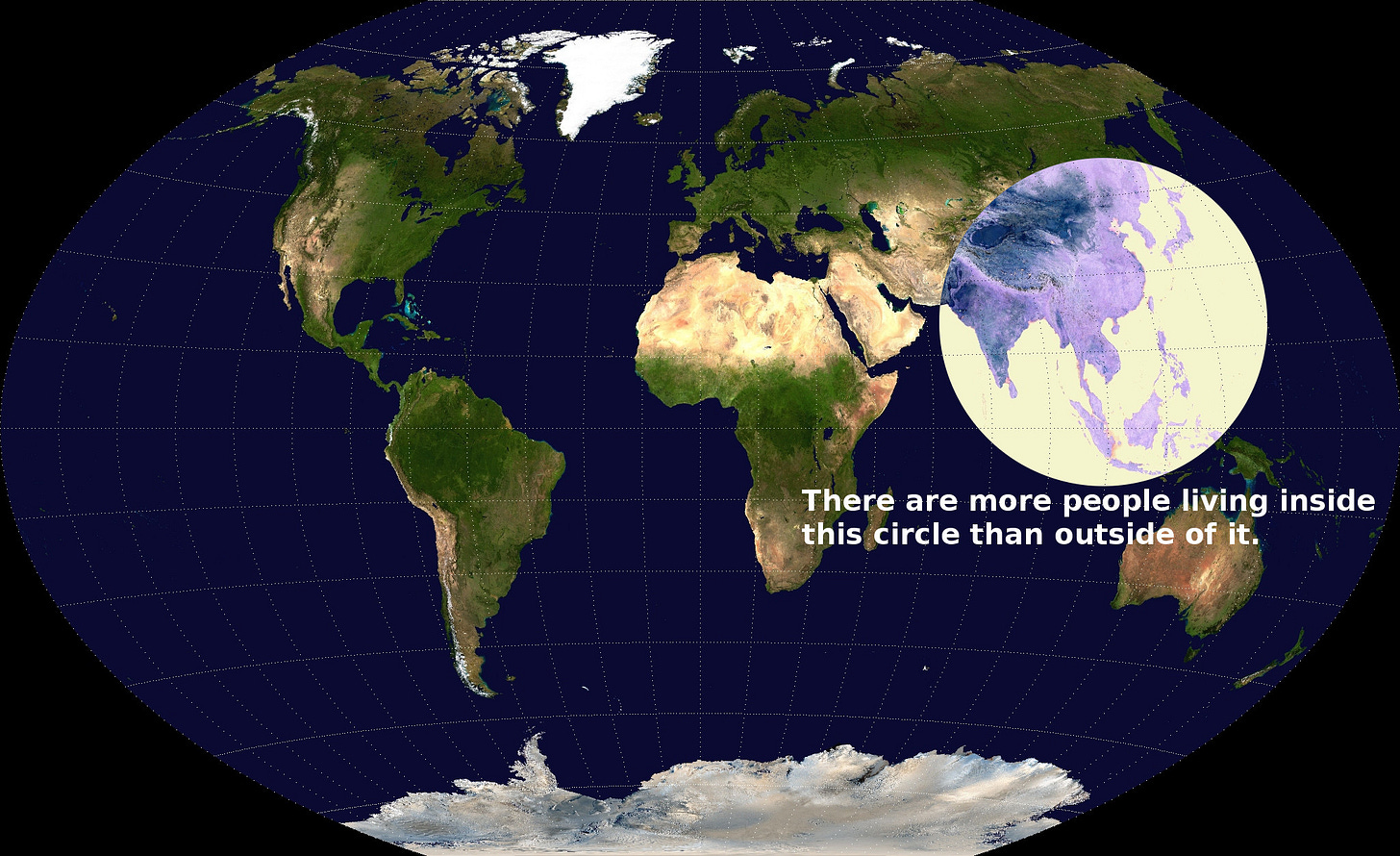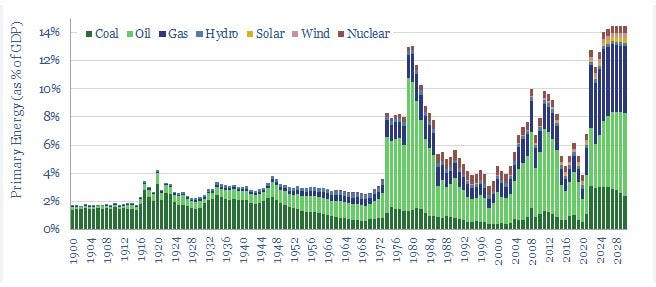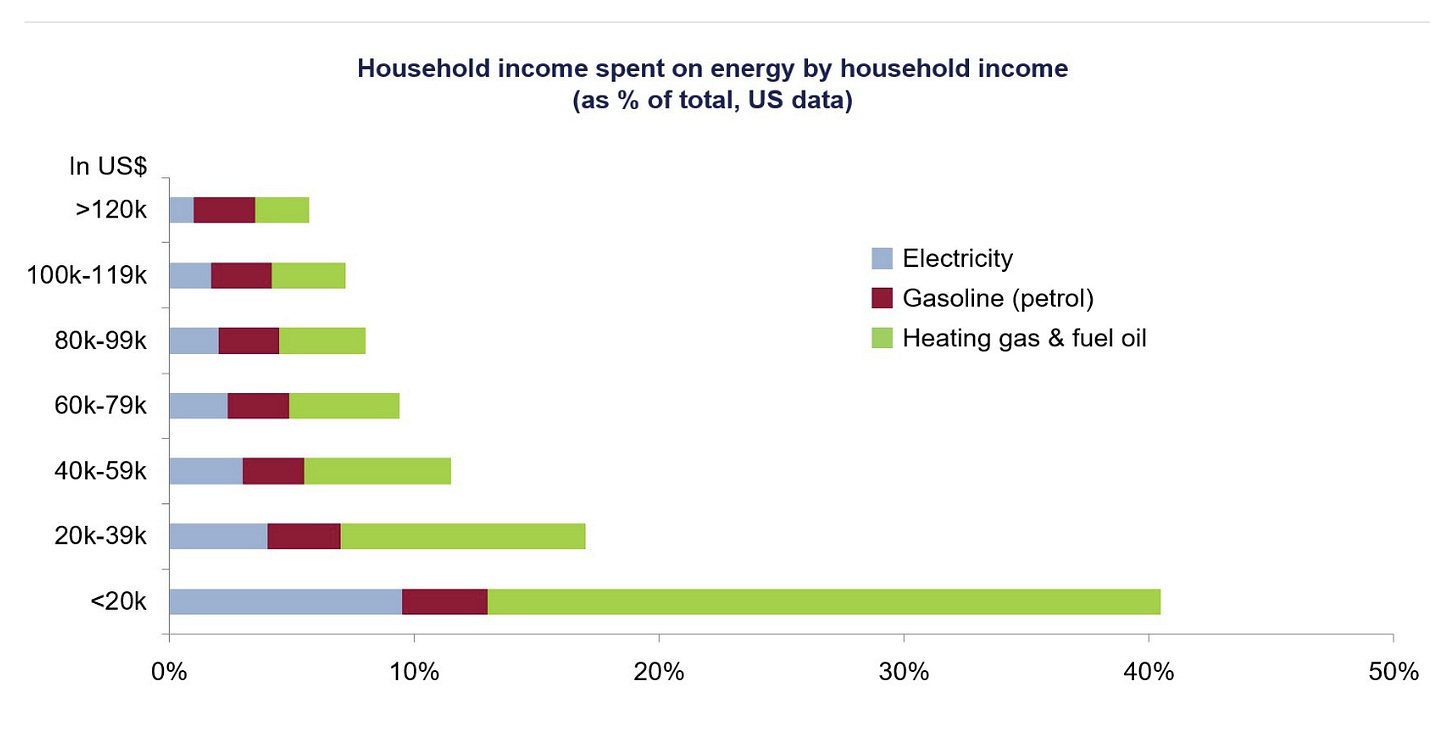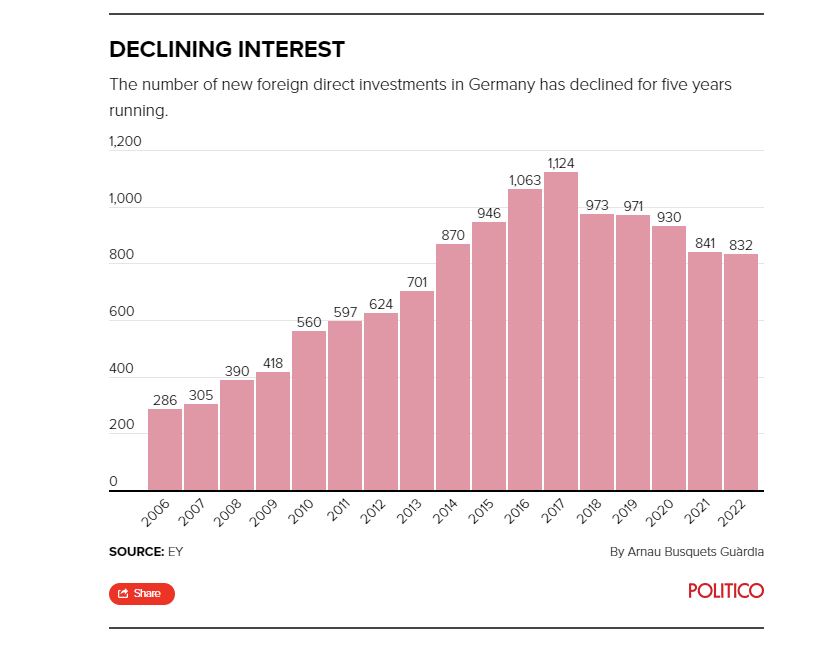The World in 2040 (Part 2)
When Energy Becomes More Expensive
In “The World in 2040 (Part 1)” I discussed how the mantra of “green energy is cheaper than alternatives” is a dangerously misleading idea. I illustrated this by looking at an extreme example - an infamous blog post imagining a “possible” city life in 2030 where everything is a service and everything is free - predicated on the innocuous starting point of: “when clean energy became free”. That blog was written in 2016 and projected 14 years hence. To keep some perspective I am imagining 2040 because 2030 now seems too close. That said, apocryphally, George Orwell wanted to call 1984, “1948” - but thought that a date so close to its publishing date would be too scary… so yes, let’s stick with 2040 and hope I am wrong about everything.
It will come as no surprise that my vision of the world in 2040 is both dystopian and framed by energy.
The Guns of October
In Barbara Tuchman’s brilliant and seminal book on the First World War (The Guns of August), she reminds readers that the carnage and destruction was not inevitable. Most of the main protagonists could see the danger of escalation, and despite their better judgement, fell into the trap. Local events in Sarajevo led to a conflagration and socio-economic upheaval that rippled through the following decades, killed millions, ended empires and fundamentally changed the world order.
The current war between Israel and Hamas could be such an event. For the moment it seems “contained”, but it didn’t happen in a vacuum - and to be clear I am not endorsing the words of UN head-honcho Gutteres. Whilst we may never know, it is easy to speculate that the Hamas attack is part of a much bigger “Great Game”. Hamas is known to be supported by Iran, just as Hezbollah is in Lebanon. Iran has aspirations to be a regional, if not global super-power. Iran has been supporting Russia in its invasion of Ukraine by supplying drones. Shia Iran seeks to dominate the Middle East, which is unsettling for the many Sunni countries, notably Saudi Arabia. The odd-man-out in the region is Qatar, which is also Sunni dominated, but has very close and cordial relations with Iran (and hosts Hamas’s political leaders). These relations are in no small part due to the cooperation that has built up over the decades of joint exploitation of the “world’s largest gas field” (South Pars / North Dome).
Gas-supply was weaponized in Russia’s invasion of Ukraine culminating in the very murky destruction of Nord Stream pipeline. It would require a series of (mis) steps for Iran and/or Qatar to follow-suit and weaponize their oil and gas supplies. But as with the First World War analogy - dominoes fell until Europe was engulfed in hostilities.
Indeed, it would be a commercial earthquake because LNG is typically supplied on long-term contracts which are predicated on trust on both sides - but when needs must? in the peak of Europe’s scramble for gas in 2022, Pakistan lost contracted gas - ENI chose to pay multi-million dollar break-fees to redirect the gas to the much higher prices Europe was prepared to pay - reportedly making $550 million profit. Poor German energy choices didn't just stop with high gas prices in Europe - but cascaded down to deprivation, job losses and deaths in places like Pakistan . Almost immediately, Pakistan approved new coal power plants right after this mess - another "win" for European energy policy.
Imagine Europe being cut off from both Russian and Middle-Eastern gas at the same time? Prices went stratospheric in the warm winter of 22-23, even with Qatar increasing its exports to Europe. Imagine.
This pre-amble is designed to highlight two points.
Firstly, that Europe is particularly exposed to supply constraints of key energy sources - gas, oil and to a lesser extent coal and uranium.
Secondly, the era of globalization and the “Rules Based Order” is changing slowly via de-globalization, but could collapse quickly in face of unexpected but rapidly escalating tensions and hostilities.
Germany just signed a 27 year gas supply contract with Qatar - it is hard to imagine that being ripped-up unilaterally. After all, in commercial relationships, the supply needs the market just as much as the market needs the supplier. However, that was also the prevailing logic that said that Russia couldn’t “afford” to invade Ukraine; the symbiotic commercial relationships with Europe were too strong. Strike one for the Rules Based Order and global trade.
Multi-Polar World
The world in 2040 could look very different from the interconnected globalized word of today, with major economic regions striving for survival. I have previously written about how poor energy policy choices are dividing the world into “Sinners and Losers”: in which those who “sin” on emissions will strengthen economically, and those who favour unilaterally reducing emissions will collapse. Pushing this logic further and we can see it driving radical changes of the globalised order that has provided prosperity and stability for many decades. Recently I wrote how a disagreement between the province of Alberta and the federal government of Canada on rules for decarbonizing the electricity sector are a foreshadowing of the stresses and fractures that are starting to show under the European federal (EU) system.
A hypothetical escalation of the conflict in Gaza is only one possibility in an ocean of uncertainty. It is impossible to predict what will be the catalyst - a major event such as an invasion of Taiwan, either side breaking the tragic stalemate in Ukraine, or the escalation of the current Israel-Hamas war, or many smaller events leading to a break-up of the international order. My guess is “death by a thousand cuts”, which in many ways will be worse because it will be harder to see it coming.
Continental Drift
As an extreme scenario, I can imagine North America (Mexico, USA and Canada) becoming an independent and essentially self-contained economic entity. This land-mass is well moated by the Pacific and Atlantic, it can produce more food than it needs and has all the energy and minerals it needs. There is an increasing tendency to re-shore industry; this would have to become total. The combined population is about 500 million, with a decent demographic pyramid (thanks to Mexico’s demographics and current immigration into USA and Canada).
Asia will become a quagmire of competing interests. India and China will vie for dominance, but if Peter Zeihan is even close to being correct, the smart money would not bet on China. The ascendency of India would be hard for non-aligned neighbours to stomach, but could happen if India can solve its resource questions. Other SE Asian (“tiger”) economies could thrive if they work together, but likewise are poor in energy resources.
Given that more than half of the world’s population lives in the Valeriepieris circle, it is clear that this huge region would need resources of all sorts, and most critically energy.
Resource Capture
Russia (and satellites), weakened by its demographic collapse and militaristic overreach would become a vassal state - exploited for its resources. Likewise, the Middle East, without its pax americana umbrella, for its oil and gas, Africa for its oil, gas, minerals, and agricultural land. So much for decolonialization. Japan, S Korea and Australia will be vulnerable if North America becomes strictly isolationist and Europe impotent.
To be clear I am neither advocating nor cheering for any of this in any way, but attempting to imagine a world in which 8bn people are competing for resources and survival in a world in which the framework of the current Rules Based System has broken down. I am no fan of the UN, but at least in global trade it has had some significant successes over the last 70 years. That said, it seems to be rapidly passing from impotence to obsolescence in global statecraft.
South/Central America, if lucky will fall within the North American sphere, but may chose a different route (understandable given a long-standing history of interference in local politics by the Yankees, but equally there are some pretty clear lessons of economic history which should point to better alignment).
Australia/Pacific - might be able to align with North America, but if the world has collapsed into this dystopia, I suspect North America will have pulled-up the draw-bridges and Australasia will have to find an uncomfortable relationship with the resource rapacious Asian economies.
The countries that are hard to place in this gross simplification are Japan and South Korea which are energy poor, economically aligned with “the West” but geographically very much in Asia. Likewise, Turkey - a country that had a 400 year empire - sits un/comfortably at the cross-roads of the Middle East, FSU and Europe. How Turkey aligns it self could have considerable consequences for any of these neighbouring regions.
But what of Europe?
Europe with a large, but rapidly aging, population (c. 750 million, but note this is only c. 450 in “western Europe” itself, the higher number includes everything west of the Urals).
Europe with lots of wind farms and solar panels, but no major oil or gas reserves, outside of Norway.
Europe that is trying to limit its ability to feed itself.
Europe that has hardly any mining left.
Europe which has offshored almost all of its manufacturing
Germany is an exception, but current policies are accelerating the deindustrialization - at exactly the wrong moment. Germany’s manufacturing base represents 30% of their economy and the German balance of payments surplus is greater that the rest of the EU countries combined - so it is critical for all of Europe. Europe does have large coal resources - which may be a blessing, but its not the cheap-and-easy to get resources : these have already been used after a 100 years of exploitation.
Death Spiral
Having discussed how Europe is exposed to its lack of energy resources, it is also critical to understand that simply “paying more” for energy can only work as a stop-gap measure not as a sustainable policy.
Energy policy was an after-thought in most of Europe - at least it was until the Russian invasion of Ukraine in 2022 (the 2014 invasion didn’t ring enough alarm bells). What masquerades as modern energy policy is primarily a decarbonization policy, where myopic focus on emissions has blinded a generation of policy makers to the importance of affordable and reliable energy.
Rising energy costs are far more insidious than simply having higher home heating bills (although these are important). At a societal level higher energy costs mean inflation - energy is used in everything from food to steel. But its much worse than just inflation. For a given standard of living energy demand is essentially inelastic. If energy costs increase two things happen:
The proportion of income (whether personal or national) spent on energy increases - with a consequent reduction in available capital for everything else. It is very easy to correlate past recessions with high energy prices - and this forecast/scenario from Thunder Said Energy for the rest of the 2020s should scare everyone witless.
.
Higher energy costs hit poorer people much more aggressively - this is true whether it be socio-economic strata within a given country as per the graphic below, or the way in which richer countries can out-bid poorer ones when commodities become scarce (c.f. discussion of Pakistan above)
Rust-Belt on the Rhine
The last two years have given a taste of what systemically higher energy costs could look like. Germany provides a stark reminder
New orders at the country’s engineering companies, long a bellwether for the health of Germany Inc., have been dropping like a stone, falling 10 percent in May alone, the eighth consecutive decline. Similar weakness is apparent across the German economy, from construction to chemicals.
Foreign interest in Germany as a place to invest is also receding. The number of new foreign investments in Germany fell in 2022 for the fifth year in a row, hitting the lowest point since 2013.
“One sometimes hears about ‘creeping deindustrialization — well, it’s not just creeping anymore,” said Hans-Jürgen Völz, chief economist at BVMW, an association that lobbies for Germany’s Mittelstand, the thousands of small- and medium-sized firms that form the backbone of the country’s economy. (source)
Put simply, the formula that made Germany Europe’s industrial powerhouse — a highly skilled workforce and innovative companies powered by cheap energy — has come undone. (source)
2040: A Multi-Polar World?
North America, isolated but independent relatively prosperous
Asia exerting a huge gravitational pull on the resource rich periphery
Europe fading into obscurity, likely riven with internecine fighting
And all of this disruption is imagined without any effects of climate change and with no pandemics as catalysts. Reliable and affordable energy have been the invisible bedrock of the growth and stability enjoyed since the end of the Second World War. Resource scarcity and/or an energy transition based on wishful thinking could undermine the prosperity and growth we have become used to, and many billions aspire to.
Qui vivra verra









Many thanks for giving this interesting and plausible perspective, however I find it very Anglo/American-centric. Also, please don't bring up Israel's ethnic cleansing operation against the Palestinian people, it's just too painful a topic!
Brilliant. Difficult to argue on the perspectives for Europe, just the speed - driven by energy deprivation policies. Your good description of the struggles for scarce resources, self-inflicted by the way, reminded me of a Mad Max scene.
Energy policy a serious thing, unfortunately being driven by hope at present.